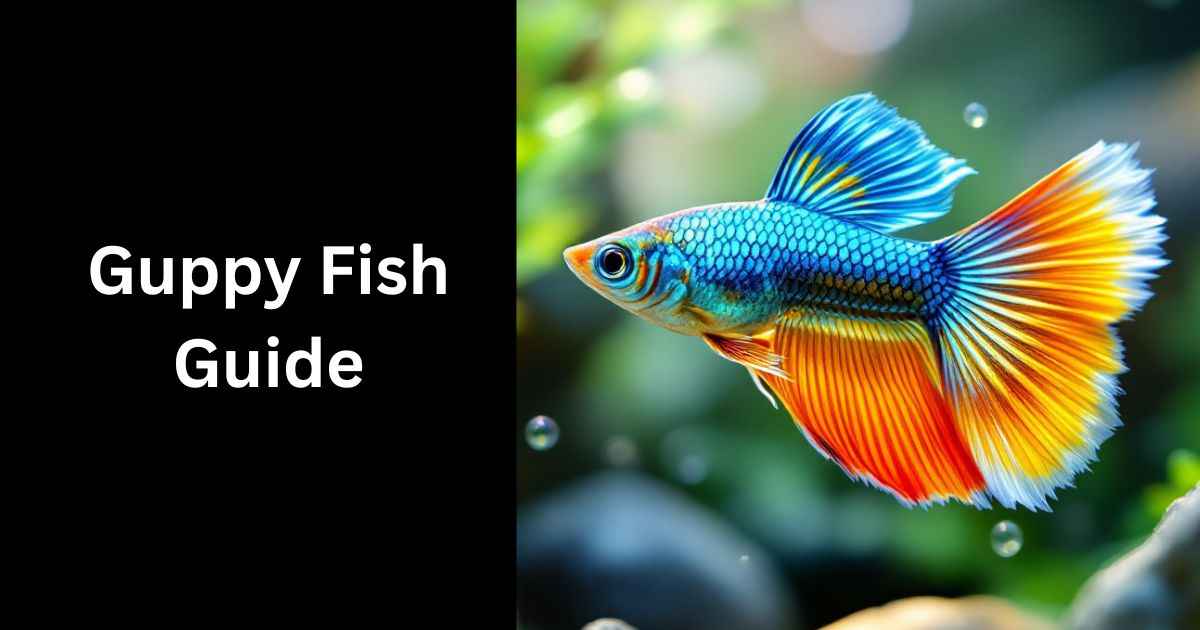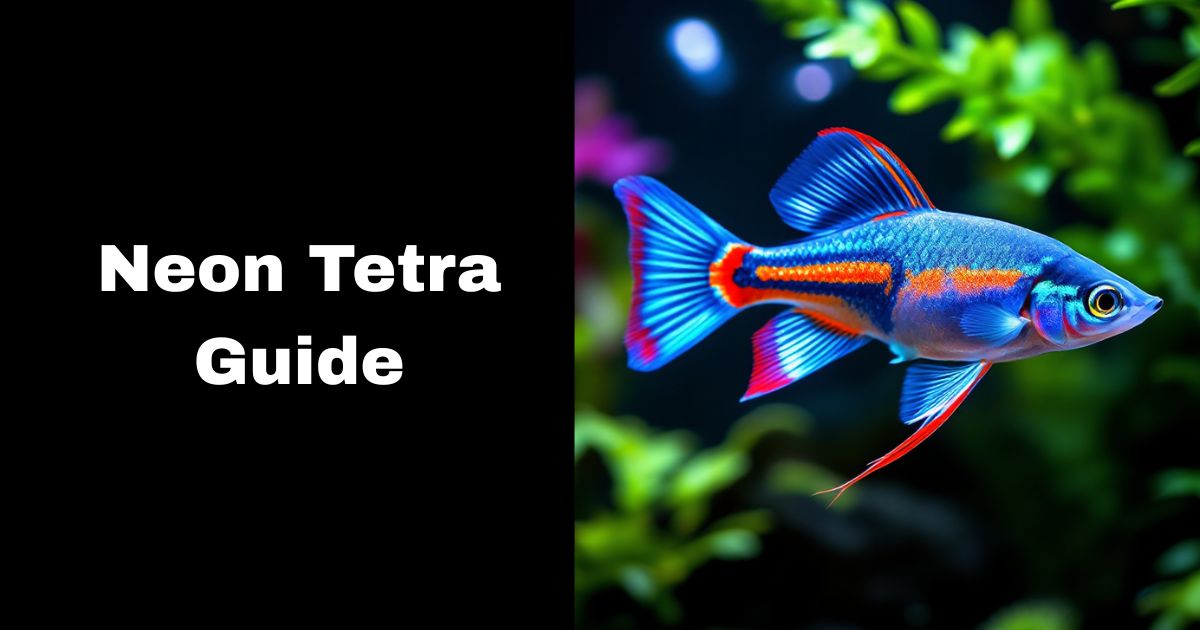Koi Betta Fish are among the most sought-after freshwater fish for aquarium enthusiasts. Known for their stunning colors, unique patterns, and striking personality, these fish are a hybrid variant of the traditional Betta splendens. Their dazzling resemblance to the Japanese Koi fish has earned them the name “Koi Betta Fish.” Whether you’re a beginner aquarist or an experienced hobbyist, caring for Koi Betta Fish can be an incredibly rewarding experience.
This comprehensive guide covers everything you need to know about Koi Betta Fish, including their care requirements, lifespan, tank mates, size, diet, and more. By the end of this article, you’ll be well-equipped to provide the perfect environment for your Koi Betta to thrive.
What Are Koi Betta Fish?

Koi Betta Fish is a color variation of Betta splendens, commonly known as Siamese Fighting Fish. They are selectively bred to have patterns and colors that mimic the appearance of Koi fish, a species of ornamental carp. Unlike traditional Betta fish, Koi Betta Fish often display a blend of red, orange, yellow, black, and white, creating a marbled effect that sets them apart.
One of the standout features of Koi Betta Fish is their marble gene, which can cause their colors to change over time. This means your Koi Betta may look completely different a few months after you bring it home, which adds to their charm and mystery.
Koi Betta Facts & Overview
| Feature | Description |
|---|---|
| Scientific Name | Betta splendens |
| Common Names | Koi Betta, Koi Betta Fish, Marbled Betta |
| Family | Osphronemidae |
| Origin | Southeast Asia (Thailand, Cambodia, Vietnam, Malaysia) |
| Lifespan | 3 to 5 years |
| Size | Around 2.5 to 3 inches (6 to 8 cm) |
| Diet | Carnivorous – primarily feeds on insects, larvae, and high-protein pellets |
| Common Colors | Red, orange, white, black, yellow, blue, multicolored (koi-like patterns) |
| Care Level | Moderate |
| Temperament | Semi-aggressive (males are territorial and aggressive towards each other) |
| Lighting | Low to moderate lighting |
| Habitat | Freshwater environments, like rice paddies and shallow ponds |
| Minimum Tank Size | 10 gallons |
| Tank Setup | Freshwater with plants and caves |
| Tank Placement | Middle to top of the tank |
| Temperature Range | 75–80°F (24–27°C) |
| pH Range | 6.5–7.5 |
| Salinity | Freshwater (no salinity required) |
| Alkalinity | 50–150 ppm |
| Propagation | Bubble nest breeding (male builds a nest and tends to the eggs) |
Types of Koi Betta Fish
Koi Betta Fish come in several variations, each with unique patterns, colors, and fin shapes. These types are influenced by selective breeding and the marble gene, which gives them their distinctive look.
1. Galaxy Koi Betta

The Galaxy Koi Betta is one of the most popular types, known for its iridescent, shimmering scales that resemble a starry galaxy. These Bettas often feature a mix of metallic blue, green, and purple hues along with traditional Koi colors like red, black, and white.
2. Candy Koi Betta
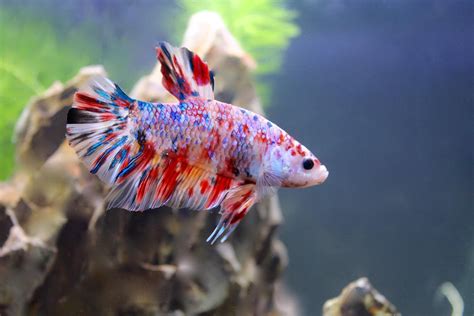
Candy Koi Bettas are vibrant and colorful, with a mix of pastel and bright hues such as pink, orange, yellow, blue, and white. Their playful coloration has made them a favorite among Betta enthusiasts.
3. Nemo Koi Betta
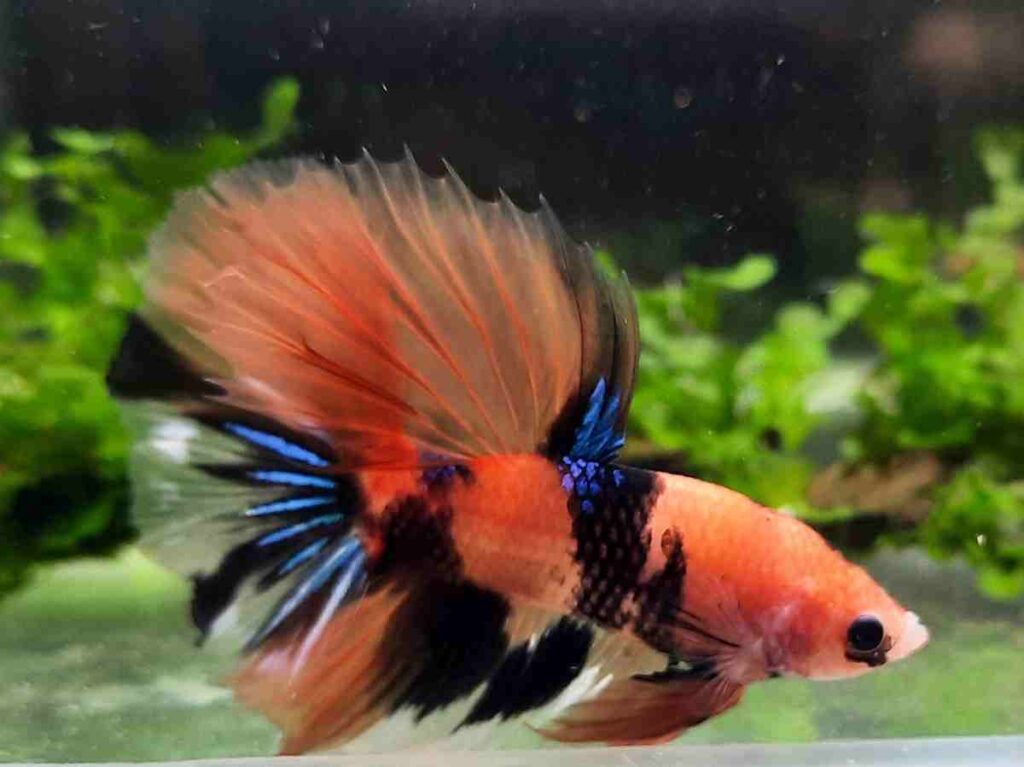
The Nemo Koi Betta is named for its resemblance to the clownfish from Finding Nemo. These Bettas typically display bold splashes of orange, black, and white, creating a striking and playful appearance.
4. Yellow Koi Betta
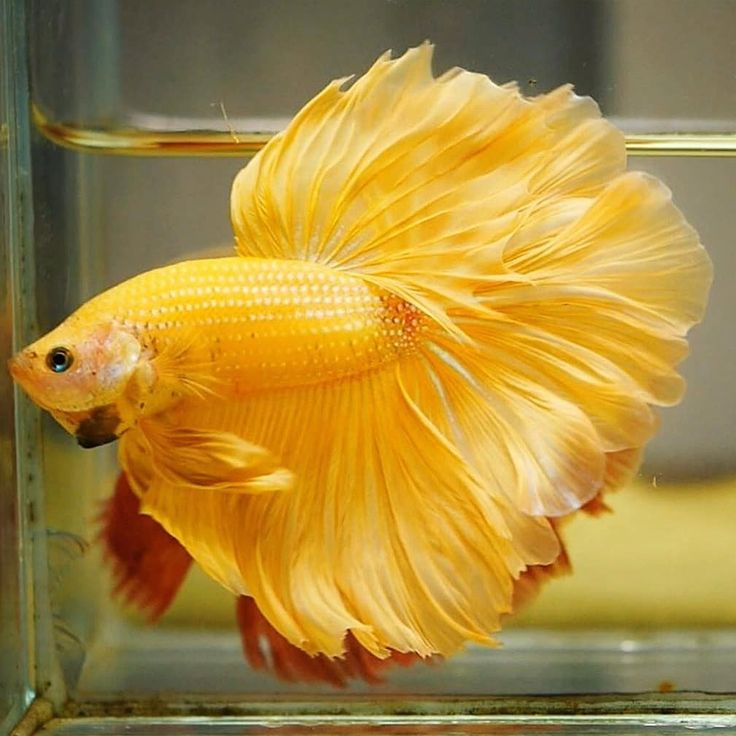
Yellow Koi Bettas are less common but highly coveted for their bright, sunshine-yellow patterns. They may also have hints of black or white, adding to their unique look.
5. Platinum Koi Betta

Platinum Koi Bettas are known for their silvery-white bodies with metallic finishes, often combined with subtle Koi-like patterns. They are elegant and stand out in any aquarium.
6. Black Koi Betta

Black Koi Bettas are darker in appearance, often featuring black as the dominant color with splashes of red, white, or orange. They are a great choice for those who prefer a more dramatic and subdued look.
7. Marble Koi Betta

Marble Koi Bettas emphasize the marble gene, showcasing constantly changing patterns and colors. These Bettas are unique because their appearance evolves, making them an exciting choice for aquarists.
Behavior & Temperament
Understanding the behavior and temperament of Koi Betta Fish is crucial for providing them with the right environment and care. These fish are known for their bold personalities, intelligence, and occasional territorial tendencies.
General Behavior
Koi Betta Fish are active swimmers and highly curious about their surroundings. They often interact with their owners, recognizing individuals and even coming to the surface for food. Their curious nature makes them fascinating to watch, as they explore their tank and inspect décor.
Territorial Nature
Like all Betta fish, Koi Betta Fish can be territorial, especially males. They will often flare their fins and gills as a display of dominance when they feel threatened or encounter another Betta. This behavior is natural and is one reason why male Bettas are best kept alone.
Aggression Levels
Male Koi Bettas are generally more aggressive than females. While aggression is usually directed toward other Bettas, they may also react to fish with long fins or bright colors, mistaking them for rivals. On the other hand, female Koi Bettas tend to be more social and can sometimes live peacefully in groups known as sororities, provided the tank is large enough and carefully managed.
Interaction with Owners
Koi Betta Fish are known for their interactive behavior with humans. They will often approach the glass when their owner is nearby, and some may even learn to take food directly from your hand. Their lively temperament makes them a favorite for those looking for a pet with personality.
Lifespan of Koi Betta Fish
The average lifespan of Koi Betta Fish is 3 to 5 years in captivity. However, with proper care, they can sometimes live up to 6 years. Their longevity largely depends on factors such as water quality, diet, and stress levels. To ensure a long and healthy life for your Koi Betta, it’s crucial to provide them with a stable and clean environment.
Tips for Extending Lifespan:
- Maintain an optimal water temperature between 76°F and 82°F (24°C to 28°C).
- Perform regular water changes to keep ammonia and nitrate levels low.
- Feed them a high-quality diet designed for Betta fish.
- Avoid overstocking the tank or introducing aggressive tank mates.
Tank Requirements for Koi Betta Fish
Creating the right environment is essential for the health and happiness of your Koi Betta Fish. While they are relatively hardy, they thrive when their tank mimics their natural habitat.
Minimum Tank Size
The minimum recommended tank size for a single Koi Betta Fish is 5 gallons. While they can survive in smaller tanks or bowls, these environments often lead to poor water quality and increased stress. A larger tank provides more swimming space and allows for better water stability.
Filtration and Water Quality
Although Koi Betta Fish can survive in low-oxygen environments due to their labyrinth organ, a good filtration system is still essential. Use a gentle filter to maintain water cleanliness without creating strong currents that could stress your Betta.
- pH Level: Maintain a pH level between 6.5 and 7.5.
- Water Hardness: Soft to moderately hard water is ideal.
- Heating: Since Betta fish are tropical, a heater is necessary to keep the water at the proper temperature.
Lighting and Décor
Koi Betta Fish appreciates subdued lighting. Overly bright lights can cause stress, so consider using adjustable LED lights or floating plants to diffuse the light. Add décor such as caves, driftwood, or live plants to provide hiding spots and mimic the natural environment.
Tank Mates for Koi Betta Fish
Choosing the right tank mates for Koi Betta Fish can be tricky due to their territorial and aggressive nature. While males are more prone to aggression, females are generally more peaceful but still require careful selection of companions.
Compatible Tank Mates:
- Snails: Nerite snails and mystery snails are peaceful and won’t bother your Betta.
- Shrimp: Ghost shrimp and Amano shrimp can cohabitate with Koi Bettas, but they may occasionally be seen as food.
- Small, Peaceful Fish: Species like Corydoras catfish, Kuhli loaches, and Ember tetras can make suitable tank mates, as long as the tank is large enough.
Tank Mates to Avoid:
- Other Male Bettas: Two male Bettas in the same tank will almost always fight.
- Fin-Nipping Fish: Avoid fish like tiger barbs or guppies that may nip at your Betta’s long fins.
- Aggressive or Large Fish: Fish like cichlids or goldfish are not suitable companions for Bettas.
When introducing tank mates, always monitor their behavior closely and remove any fish that show signs of aggression or stress.
Size of Koi Betta Fish
Koi Betta Fish are typically 2.5 to 3 inches in length, including their fins. Some larger specimens may reach up to 4 inches, depending on their genetics and care. Their compact size makes them ideal for smaller tanks, but their vibrant personalities make them stand out in any aquarium.
Diet and Feeding for Koi Betta Fish
A proper diet is critical to keeping your Koi Betta Fish healthy and vibrant. In the wild, Bettas are carnivorous and feed on insects and insect larvae. In captivity, they thrive on a diet of high-protein foods.
Recommended Diet:
- Pellets: High-quality Betta-specific pellets should form the staple of their diet. Look for options with high protein content.
- Frozen or Live Foods: Treat your Betta with foods like bloodworms, brine shrimp, and daphnia. These mimic their natural diet and provide essential nutrients.
- Occasional Vegetables: While not a primary food source, blanched peas can be offered occasionally to aid digestion.
Feeding Tips:
- Feed your Koi Betta once or twice a day in small amounts. Overfeeding can lead to bloating and poor water quality.
- Remove any uneaten food after 2-3 minutes to prevent it from decomposing in the tank.
- Consider fasting your Betta for one day per week to promote digestive health.
Common Health Issues in Koi Betta Fish
Koi Betta Fish, like all Betta species, are prone to certain health issues. Understanding the signs and symptoms of common diseases can help you address problems early.
Common Health Problems:
- Fin Rot: Caused by bacterial infections, fin rot leads to frayed or discolored fins. Treat with antibacterial medications and improve water quality.
- Ich (White Spot Disease): Characterized by white spots on the body and fins, ich is caused by parasites. Raise the water temperature slightly and use anti-parasitic treatments.
- Swim Bladder Disorder: Affects the fish’s ability to swim properly, often caused by overfeeding or constipation. Fasting and feeding blanched peas can help.
- Velvet Disease: A parasitic infection that appears as a gold or rust-colored coating on the fish. Treat with copper-based medications and ensure proper tank conditions.
Preventative Measures:
- Maintain pristine water conditions through regular water changes.
- Avoid overfeeding, as uneaten food can degrade water quality.
- Quarantine new fish or plants before introducing them to the tank.
Breeding Koi Betta Fish
Breeding Koi Betta Fish can be a rewarding but challenging process. It requires careful planning and attention to detail.
Basic Breeding Steps:
- Pair Selection: Choose a healthy male and female Koi Betta with desirable colors and patterns.
- Breeding Tank Setup: Use a separate 5-10 gallon tank with warm water (around 80°F) and a bubble nest area for the male.
- Introducing the Pair: Place the female in a separate container within the tank so the male can see her without direct contact. Once the male builds a bubble nest, release the female.
- Spawning: The male will wrap around the female during spawning, releasing eggs into the bubble nest. Remove the female after spawning to prevent aggression.
- Caring for Fry: The male will tend to the eggs until they hatch. Once the fry is free-swimming, remove the male to prevent him from eating them.
Breeding Koi Bettas requires patience and experience, as not all attempts are successful. Be prepared to care for the fry until they are old enough to be rehomed.
Why Choose Koi Betta Fish?
Koi Betta Fish are an excellent choice for aquarists looking for a colorful and low-maintenance pet. Their striking appearance, coupled with their interactive and curious nature, makes them a joy to watch. Additionally, their ability to adapt to smaller tanks means they are accessible to beginners and experienced hobbyists alike.
Related Articles:
- Signs of a Guppy in Labor: What Every Fish Keeper Should Know
- Guppy Fish Pregnancy: A Complete Guide to Care and Breeding Tips
- Top 10 Aquarium Plants for Guppy Tanks
FAQs
Are Koi Betta Fish Rare?
Koi Betta Fish are not extremely rare, but they are unique and sought after due to their striking colors and patterns. While they can be found at specialty aquarium stores and from breeders, specific variations may be less common.
Why Are Koi Bettas So Expensive?
Koi Bettas can be expensive due to their unique coloration and patterns, which result from selective breeding. The marble gene also adds to their value, as it causes their colors to change over time, making each fish unique. Additionally, the demand for these striking fish often exceeds supply, further driving up their price.
Do Betta Koi Fish Sleep?
Yes, Koi Betta Fish do sleep, although not in the same way humans do. They typically sleep more at night and may take short naps during the day. Bettas prefer to rest on flat surfaces or among plants in their aquarium.
How to Keep Betta Fish Happy?
To keep Betta fish happy, provide a suitable tank of at least 5 gallons with clean, warm water (around 76-82°F or 24-28°C). Include hiding spots, plants, and decorations for enrichment. Feed a varied diet of high-quality pellets and occasional treats, and maintain consistent water quality through regular changes. Avoid overcrowding and ensure tank mates are compatible.
Why Do Koi Jump Out of Tank?
Koi may jump out of their tank due to stress, poor water quality, or inadequate space. They might also jump in search of food or to escape perceived threats. Ensuring a well-maintained environment with appropriate tank size and secure covers can help prevent this behavior.
Do Koi Betta Fish Need a Heater?
Yes, Koi Betta Fish typically need a heater to maintain a stable water temperature between 76-82°F (24-28°C). This temperature range is crucial for their health and well-being, as Betta fish are tropical species that thrive in warmer water.
Conclusion
Koi Betta Fish are stunning, unique, and rewarding pets that can bring life and vibrancy to any aquarium. By understanding their care requirements, lifespan, suitable tank mates, size, diet, and health needs, you can provide the ideal environment for your Koi Betta to thrive.
Always remember that the key to a happy and healthy Koi Betta Fish is a clean, well-maintained tank, a high-protein diet, and plenty of love and attention. With proper care, your Koi Betta will reward you with years of beauty and companionship.
So, if you’re looking to add a splash of color and personality to your aquarium, the Koi Betta Fish may be the perfect choice for you!


